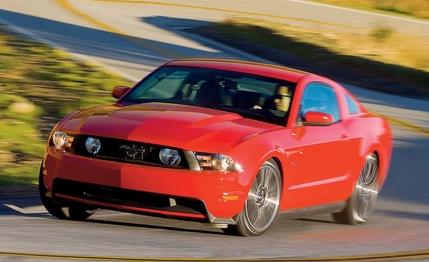 First Drive Review
First Drive Review
Nearly five years after the Mustang’s last major redo, fervent fans of Ford’s seminal pony car might have been hoping for an all-new 2010 model—especially considering the new Dodge Challenger and Chevy Camaro models with which it will compete. Instead, Ford has launched a thoughtful upgrade, improving the areas that most needed help.
Number one was the interior, which had a retro look but consisted of hard plastic panels pieced together with numerous seams. From behind the wheel, the most obvious change is an instrument panel that stretches from door to door and from the base of the windshield to the top of the center console. This thermoplastic olefin molding feels squishy and looks rich. The twin-cowl theme of the current car continues, but it’s upgraded with more metallic trim and less plated plastic, a new instrument cluster with fully round dials, and an optional nav system with a huge, eight-inch screen and the latest version of the Ford/Microsoft Sync telematic system.
Outside, the new model is plainly a face lift rather than an all-new design, bearing a closer resemblance to the ’69 Stang than the current car. The four-light grille—the inner two are actually large fog lights—and the kicked-up rear fender lines come straight from the ’69 car. Otherwise, the sheetmetal is beveled at both ends, and there’s a pronounced hood bulge—the new model looks both more muscular and a bit smaller than the current one, which in some ways seems like a cleaner and more coherent design.
The new skin, in combination with fairings under the engine, reduces drag by seven percent and front lift by 23 percent on the GT models we drove, according to Ford. And in the rear, each of the LED taillights has three separate elements that light up sequentially, as did the turn signals of certain vintage Thunderbirds.
Underneath, the 2010 model is largely carried over, with key additions to improve stiffness and upgrade the ride and handling. Using the current car’s Bullitt package as the starting point, the new car gets 17 percent stiffer rear springs, and recalibrated shocks with markedly more compression damping and somewhat stiffer rebound damping. The changes are said to reduce body roll during hard cornering by about ten percent.
The V-8–powered GT now comes standard with 8 x 18-inch wheels (up from 8 x 17s), and the standard rubber is a Mustang-specific 235/50ZR Pirelli P Zero Nero all-season tire, a further development of the 17-inch Neros on the current GT. In Ford testing, these tires perform well in snow and deliver 0.84 g of dry cornering grip. Upgrading to 245/45ZR-19s mounted on 8.5-inch-wide rims raises grip to a claimed 0.90 g. The last GT we tested pulled 0.89 g on all-season Neros.
Ford finally is offering a TrackPack, which includes 255/40ZR-19 P Zero summer tires, stiffer shocks, higher-performance brake pads, a 3.73 axle ratio instead of a 3.31, rear trailing links with stiffer bushings, a strut tower brace, and larger anti-roll bars (the tubular 34mm front bar goes from 5.1 to 5.8 mm wall thickness and the solid rear bar increases from 20 to 24mm). With all of these changes, Ford says maximum grip increases to 0.93 g, while body roll is reduced a further ten percent.
The larger standard wheels and tires add only 15 pounds to the Mustang, which is a good thing because power hasn’t gone up much. Thanks to a cold-air system based on that of the Bullitt Mustang, power is up from 300 to 315 horsepower, and torque grows a modest five pound-feet to 325. The redline is also up from 6250 to 6500 rpm, matching the Bullitt’s. The cold-air system is said to cut 0-to-60 times by 0.3 second away from a stoplight, when the engine has been heat-soaking while idling at the light. The transmissions are unchanged with a choice of a standard five-speed manual or an optional five-speed automatic.